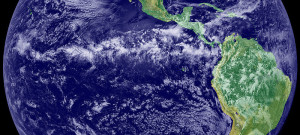By Luisa Cristini, PhD, University of Hawaii at Manoa
[Note from the editor: This will be the first in a series of blog entries that will focus on introductory topics in climate dynamics and modeling, and will be a great insight into the current understanding of the science.]
The atmosphere is the most important component of Earth’s climate system. An introduction to atmospheric composition, properties and circulation is given in an easy-to-read, freely available, online book from the Université Catholique de Louvain.
 Dry air (i.e., without its water vapor) is mainly composed of nitrogen (78% in volume), oxygen (21%), argon (0.93%), carbon dioxide (0.038%) and various trace constituents such as neon, helium, methane and krypton. Additionally, highly variable amounts of water vapor are also present, from approximately 0% in the coldest parts of the atmosphere to 5% in moist regions.
Dry air (i.e., without its water vapor) is mainly composed of nitrogen (78% in volume), oxygen (21%), argon (0.93%), carbon dioxide (0.038%) and various trace constituents such as neon, helium, methane and krypton. Additionally, highly variable amounts of water vapor are also present, from approximately 0% in the coldest parts of the atmosphere to 5% in moist regions.
The atmospheric pressure is at its maximum at the Earth’s surface and decreases with height, a condition that arises from the Earth’s atmosphere being in hydrostatic balance. The temperature in the lowest part of the atmosphere, or troposphere (roughly the first 10 km) generally decreases with height, and the rate of this decrease is called the lapse rate. The lapse rate is an important quantity because it determines the vertical stability of the atmosphere. Low values of lapse rate mean that the atmosphere is very stable, which will inhibit clouds and precipitation from forming. With higher lapse rate values (temperature decreasing faster with height), the atmospheric stability decreases, leading to a greater chance for clouds, convection, and precipitation.
Above the troposphere, the stratosphere extends to about 50 km height. Here the temperature increases with height. Above the stratosphere is the mesosphere, where temperature decreases strongly with height until the thermosphere is reached at around 80 km, where temperature then increases with height once more. The increasing/decreasing of temperature above 10 km is strongly influenced by the absorption of solar radiation by atmospheric constituents and by chemical reactions. In particular, the warming in the high stratosphere is mostly due to the absorption of ultraviolet radiation by a layer of ozone, which protects life on Earth from this dangerous radiation.
The atmospheric humidity has maximum values in the lower layers of the troposphere and decreases with height. This is due to the fact that the major source of water vapor in the atmosphere is evaporation at the surface. Also, warmer air (i.e. air close to the surface) is able to hold larger amounts of water before becoming saturated than can higher, colder layers. Saturation leads to the formation of clouds and, eventually, precipitation.
At the Earth’s surface, the temperature is highest closer to the equator because of the higher incoming solar radiation year-round. The global distribution of the surface temperature is also influenced by atmospheric and oceanic heat transport (for example the Atlantic Gulf Stream keeps Northern Europe comparatively warm) and the topography, among other processes.
The large-scale atmospheric circulation is mainly driven by changes in density and by the Earth’s rotation. The air at the equator is less dense due to its higher temperature and tends to rise upward before being transported poleward at high altitudes. This motion is compensated for by an equator-ward displacement of air at the surface. The two cells (one in each hemisphere) driven by the upward movement at the equator (Hadley cells) terminate with a downward moving branch at a latitude of about 30°. At the surface the Earth’s rotation deflects the flow coming from mid-latitudes to the Equator towards the right in the Northern Hemisphere and towards the left in the Southern, called the Coriolis Force. This is the reason for easterly trade winds in tropical regions.
The equator-bound air of the two hemispheres meet close to the equator in a band called the Intertropical Convergence Zone (ITCZ) resulting in colliding air and rising motion, which causes heavy precipitation. Because of the geometry of the continents, the ITCZ is located around 5°N and shifts throughout the seasons. Further north (and south) from the equator, weather regimes are dominated by westerly winds and Ferrel cells, mirror images of Hadley cells.
The large-scale atmospheric circulation has a strong influence on precipitation. Along the ITCZ, the cooling of warm, moist surface air during its rising motion leads to condensation and heavy precipitation in this area. In contrast, sinking motion in the subtropics is associated with the presence of dry air and low precipitation rates. For this reason the majority of the large deserts on Earth are located in the sub-tropical belt.
Keep in mind that broad-scale rising motion is associated with clouds and precipitation, while broad-scale sinking motion is associated with clear skies and dryness.
The presence of land surfaces has a critical role in the monsoon circulation. A monsoon is a seasonal reversal of surface winds caused by the differential heating of a land mass and its adjacent ocean. The monsoon strongly affects the precipitation over subtropical continents. During the winter monsoon, the inflow of dry continental air is associated with low precipitation. On the other hand, the summer brings moist air from the ocean inducing heavy rainfall for months at a time.
The land topography also plays an important role in precipitation as it can generate vertical motion when air masses collide with mountain boundaries. Where upward movement of moist air is topographically induced, massive precipitation can occur. If downward motion of dry air is generated on the lee side of nearby mountains, the precipitation will be low.
Over the oceans in the mid-latitudes, precipitation in winter is mainly due to low-pressure systems called cyclones which tend to follow a common path at about 45°N in the Pacific and the Atlantic along the jet stream. Since the Earth is unevenly heated at the equator vs. the poles, cyclones can be thought of as a way for masses of cold air from the poles to mix with masses of warmer air from the equator in an attempt to restore thermal equilibrium. The path that cyclones tend to follow in mid-latitudes, called their storm-track, results in considerable precipitation in these regions, either in the form of rain, snow, or mixed precipitation.
Reference:
Goosse H., P.Y. Barriat, W. Lefebvre, M.F. Loutre and V. Zunz, (2012). Introduction to climate dynamics and climate modeling. Online textbook available at http://www.climate.be/textbook


Comments are closed.